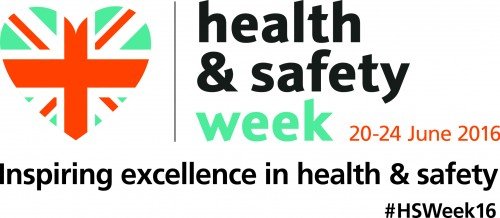Ahead of Health and Safety Week: Keeping staff out of danger

According to the Health and Safety Executive (HSE), in 2014/15 over 1.2 million people were suffering from a work-related illness and 76,054 non-fatal injuries were reported. Although Britain has one of the best health and safety records worldwide, this figure shows there is still room for improvement to ensure staff are not put in danger at work. With the UK’s Health and Safety Week taking place from 20-24 June 2016, Carrie Earl, category manager at IronmongeryDirect, takes a look at reducing workplace hazards and suggests some useful tools to minimise the risk of injury.
Every year, 23 million working days are lost due to illness and injuries caused by today’s working conditions. Reducing potential hazards in the workplace is a must to protect employee well-being and ensure that businesses are legally compliant. Regardless of the industry a business is operating in, all organisations have a legal duty to ensure they have adequate health and safety procedures in place to keep their staff safe. Not only this, all staff have the right to feel safe and secure when they’re at work. Taking precautions to provide a safe environment for employees can dramatically reduce the risk of incidents occurring and should be a main priority for all companies.
In order to implement appropriate health and safety policies and procedures, there are a number of factors that must be taken into account to create the safest possible setting for workers. Generally, this will depend on the size of the business and the potential hazards. But how can health and safety professionals ensure risks are effectively managed?
Recognising and managing risks
Developing an effective safety plan starts by carrying out a risk assessment to identify all possible hazards and dangers that could affect the health and safety of employees. As such, the level of detail recorded in the assessment should relate to the level of risk. For example, employees working with dangerous chemicals, moving heavy items or operating large machinery are at higher risk of incurring injury than an office worker. It’s also important to carry out the assessment on a frequent basis to ensure it’s always up-to-date, as throughout the life of a business, new equipment, technology or processes will be introduced. This could lead to the creation of new hazards, which will all need to be addressed promptly.
Once an assessment has been carried out and all potential risks have been identified, sensible measures can then be put in place to control them and reduce the chance of an incident occurring. Key considerations should be to think about how the hazard may affect employees, who else may be affected and how this can be managed. Can the risk be removed, or are there practical steps that can be taken to lower the chance of harm? It’s also useful to check past inspections or accident reports to see where improvements can be made, and ensure previous incidents, if any, do not happen again.
Providing staff with regular work-appropriate training
After carrying out a risk assessment, employers are required to let employees know of the potential hazards they may be exposed to. By offering regular training to staff on how to use equipment and how to follow safety procedures, employees will know how to work safely and what to do if an incident does occur.
Employees will require training that reflects their responsibilities, so for example, if a worker is using a particular piece of equipment, they will need to know how to use this safely and how to take the necessary precautions.
Also, young or vulnerable staff may require adequate supervision and training that is tailored to their particular needs. This could apply to those with limited mobility or inexperienced staff, for example. When introducing any new equipment or changes to business processes, workers must be notified and suitably trained so they can continue to work appropriately.
Keeping a work environment safe isn’t just down to employers, however. Employees also have an important role to play and have a responsibility to follow any health and safety instructions or training provided. If staff are not compliant with procedures, then this could have serious implications for themselves and other employees.
Providing trusted safety equipment
When carrying out potentially dangerous or hazardous tasks, all employees should be supplied with suitable personal protective equipment (PPE) to protect against possible injury or illness. This can include items such as safety helmets, gloves, aprons, eye protection, high-visibility clothing, safety footwear and safety harnesses. Alongside this essential equipment, there are also extra handy tools available, which can reduce the risk of accidents and illness, such as cutting machines with special safety guards or extractor machines to remove harmful airborne substances.
A common cause of injuries in the workplace comes from lifting and moving heavy objects, a task often undertaken by those working in manual trades sectors such as construction. In light of this, there are a number of new devices that have been developed, which can help take some of the weight and make lifting safer and easier. For example, the Roughneck Gorilla Gripper is an innovative product that has been designed to grip, lift and carry large sheets of material, doors and worktops. It removes the need to bend or lift, therefore reducing potential injury to the back, wrist or fingers.
Other risks can occur when working in small, restrictive areas or environments with limited visibility. This can be extremely dangerous if staff are operating vehicles or heavy machinery and could heighten the chance of an accident occurring. In areas where vehicles tend to operate, such as warehouses and carparks, it’s of vital importance to increase the visibility of obstacles and highlight any hazardous zones. For example, Reflective Rubber Corner Protectors are an ideal solution because the yellow and black stripes stand out to provide warning and the rubber design will absorb and deflect the impact of any vehicle collisions.
Overall, there are various elements and factors to consider when implementing effective health and safety procedures. However, strategic planning will make the process much simpler and will come down to how well the risk assessment is carried out. From here, the necessary steps can be taken to keep the risks to a minimum, be this through implementing stringent safety procedures and adequate training or providing the newest safety equipment. The health and safety of staff is absolutely paramount and it is the employer’s responsibility to ensure that workers are not put in danger.
For more information, please visit http://www.IronmongeryDirect.co.uk/
Find out more about the UK’s Health and Safety Week here. Download the banners and show your support for Health and Safety Week here.
#HSWeek16

Carrie Earl, category manager at IronmongeryDirect.
Ahead of Health and Safety Week: Keeping staff out of danger
According to the Health and Safety Executive (HSE), in 2014/15 over 1.2 million people were suffering from a work-related
Safety & Health Practitioner
SHP - Health and Safety News, Legislation, PPE, CPD and Resources
Related Topics
Legionella Management: Who can be appointed as RP, DRP, AP or CP?
James Macpherson on risk: ‘More of the same won’t work’
New IOSH study centre aims to support Level 6 Diploma



Following the links to get a banner and it all says 2015 not 2016
Hi Liz,
Can you try downloading the banners from this page here: https://www.shponline.co.uk/health-safety-week-2016/ They should all be 2016, but let me know if you have any further problems and I will send them to you directly.
Roz
HAVE YOU WATCHED THE VIDEO ATTACHED WITH THE ROUGHNECK GORILLA GRIPPER , IT SHOWS A MAN GRIPPING TWO LARGE SHEETS OF PLYWOOD THEN CLIMBING A LADDER WITH ONE HAND, THIS MEANS HE IS REMOVING HIS FREE HAND PERIODICALLY THUS NOT HAVING 3 POINTS OF CONTACT AT ALL TIMES, NEVER MIND HE WILL BE SEVERELY OFF BALANCE WHILST DOING THIS. I AM NOT SURE THIS PROMOTES A SAFE PRACTICE. AS AN ADDENDUM I JUST CONTINUED WATCHING AND ALSO NOTED HE IS LEANING OUT OF A ROOF SPACE AT HEIGHT AND IS NOT WEARING ANY FORM OF FALL ARREST OR HARNESS.